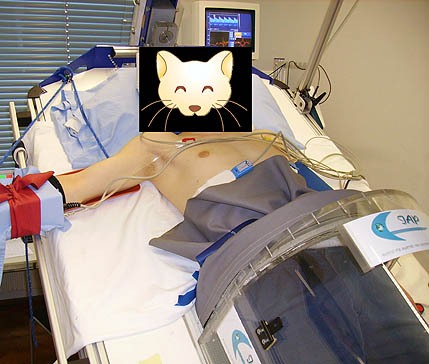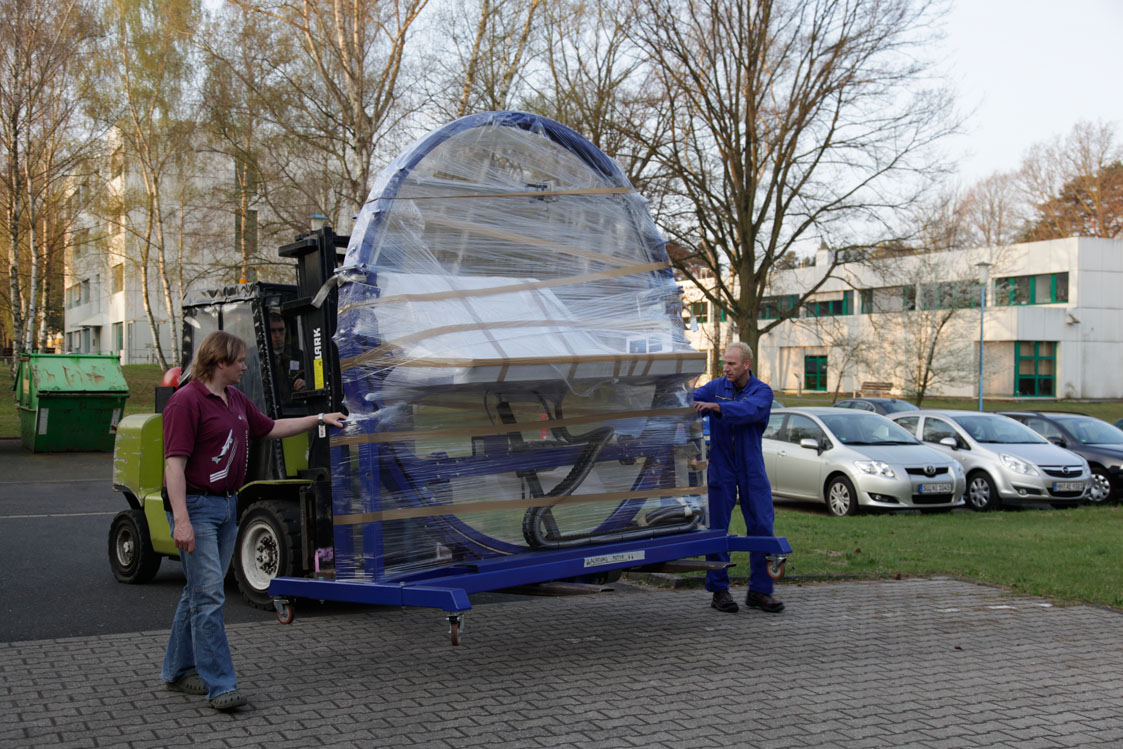
A test device,
developed and built by IAP, for freely adjustable, automated, combined
change of
 pitch (+70°
head-up to -70° head-down tilt) and
pitch (+70°
head-up to -70° head-down tilt) and
 yaw (+30° to -30° sidewards slant).
yaw (+30° to -30° sidewards slant).
In addition, a lower
body pressure system allows for LBNP or LBPP simulated (anti-)orthostasis.
Transition between any
possible combination of stimuli is reached smoothly via computer setting
in <60s.
A special laser system allows for precisely reproducible positioning
of electrodes for thoracic impedance monitoring. The setup has a master
clock system for internal synchronization of stimulus setting and data recording,
and external protocol elapsed time display for precise (blood) sample timing,
The resilience of the human cardiovascular system (blood pressure
stability, orthostatic tolerance) can be studied using various techniques.
Amongst those are centrifuge rides that expose humans to high G loads until
they may reach a point where loss of consciousness (LOC) occurs.
Using our Automated Multi-Stimulation Test Device, we assess cardiovascular
stability simply by using a combination of passive head up tilt and additional
lower body suction (LBNP) of increasing magnitude, until a presyncopal point
(status immediately preceding syncope, or LOC) is reached.
Amongst the standard monitoring approaches used in these investigations
are hemodynamic (blood pressure, cardiac output) and brain perfusion measurements
(Doppler ultrasound a. cerebri media blood flow).
We could show that individual tolerance times, and cardiovascular response
patterns, are well reproducible. This test provides valuable information
on human cardiovascular stability.

>> Head down tilt
Visceral afferents influence the perception of body positioning, and
vestibular stimuli alter cardiovascular regulation. In this way, investigations
of regulatory aspects within a certain subsystem may be influenced by parallel
changes within an intermeshed other subsystem, which may go unnoticed but
potentially confound interpretation of the results - as altered baroreceptor
sensitivity with adaptation to ‘weightless’ conditions may be affected
by parallel changes within vestibular, somatosensory, or visceral systems.
Our investigations are designed
to define how cardiovascular effects of passive head down tilt positioning
(i.e., simulated weightlessness) can be nullified by applying, at the
same time, certain amounts of lower body ‚negative’ pressure.
LBNP is
used to simulate orthostasis by pooling blood in the lower extremities.
Similar to upright positioning, it induces decreased cardiac preload and
baroreceptor unloading as a direct hydrostatic effect.
This is followed
by reflex effects: Heart rate and peripheral arterial resistance rise,
and certain hormones try to stabilize the cardiovascular functioning. Increased
filtration pressures in lower body parts lead to hemoconcentration, mirrored
by a rise in hematocrit and plasma protein concentration and plasma
mass density.
Studies have demonstrated
stimulus 'dose responses' for heart rate and dimensions, central
venous pressure, stress dependent hormones, and body fluid shifts.
Antiorthostasis
(head down tilt) empties lower leg veins and causes opposed cardiovascular
effects. LBNP and HDT can be applied in combination, therefore it is possible
to investigate whether certain stimulus pairs's effects simply cancel
out each other, given the right intensities.
Further, it is unknown if
HDT / LBNP combinations produce no effect i.e., balance each other
on cardiovascular and hormonal variables in humans. We experimentally
determine nullifying HDT-LBNP stimulus pairs to answer that question.
Photo:
© Karl Pilz
A new version of the AMST device has
been built for DLR Cologne (Germany) as part of our scientific cooperation and delivered in 2009 (photo below)



 pitch (+70°
head-up to -70° head-down tilt) and
pitch (+70°
head-up to -70° head-down tilt) and  yaw (+30° to -30° sidewards slant).
yaw (+30° to -30° sidewards slant).